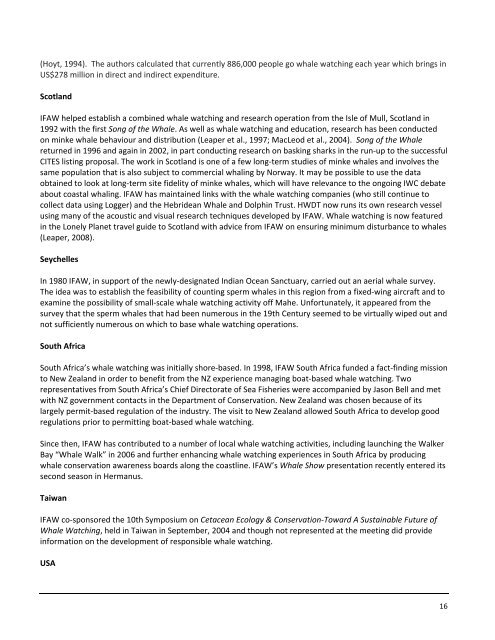Whale Watching Worldwide
Whale Watching Worldwide
Whale Watching Worldwide
You also want an ePaper? Increase the reach of your titles
YUMPU automatically turns print PDFs into web optimized ePapers that Google loves.
(Hoyt, 1994). The authors calculated that currently 886,000 people go whale watching each year which brings in<br />
US$278 million in direct and indirect expenditure.<br />
Scotland<br />
IFAW helped establish a combined whale watching and research operation from the Isle of Mull, Scotland in<br />
1992 with the first Song of the <strong>Whale</strong>. As well as whale watching and education, research has been conducted<br />
on minke whale behaviour and distribution (Leaper et al., 1997; MacLeod et al., 2004). Song of the <strong>Whale</strong><br />
returned in 1996 and again in 2002, in part conducting research on basking sharks in the run‐up to the successful<br />
CITES listing proposal. The work in Scotland is one of a few long‐term studies of minke whales and involves the<br />
same population that is also subject to commercial whaling by Norway. It may be possible to use the data<br />
obtained to look at long‐term site fidelity of minke whales, which will have relevance to the ongoing IWC debate<br />
about coastal whaling. IFAW has maintained links with the whale watching companies (who still continue to<br />
collect data using Logger) and the Hebridean <strong>Whale</strong> and Dolphin Trust. HWDT now runs its own research vessel<br />
using many of the acoustic and visual research techniques developed by IFAW. <strong>Whale</strong> watching is now featured<br />
in the Lonely Planet travel guide to Scotland with advice from IFAW on ensuring minimum disturbance to whales<br />
(Leaper, 2008).<br />
Seychelles<br />
In 1980 IFAW, in support of the newly‐designated Indian Ocean Sanctuary, carried out an aerial whale survey.<br />
The idea was to establish the feasibility of counting sperm whales in this region from a fixed‐wing aircraft and to<br />
examine the possibility of small‐scale whale watching activity off Mahe. Unfortunately, it appeared from the<br />
survey that the sperm whales that had been numerous in the 19th Century seemed to be virtually wiped out and<br />
not sufficiently numerous on which to base whale watching operations.<br />
South Africa<br />
South Africa’s whale watching was initially shore‐based. In 1998, IFAW South Africa funded a fact‐finding mission<br />
to New Zealand in order to benefit from the NZ experience managing boat‐based whale watching. Two<br />
representatives from South Africa’s Chief Directorate of Sea Fisheries were accompanied by Jason Bell and met<br />
with NZ government contacts in the Department of Conservation. New Zealand was chosen because of its<br />
largely permit‐based regulation of the industry. The visit to New Zealand allowed South Africa to develop good<br />
regulations prior to permitting boat‐based whale watching.<br />
Since then, IFAW has contributed to a number of local whale watching activities, including launching the Walker<br />
Bay “<strong>Whale</strong> Walk” in 2006 and further enhancing whale watching experiences in South Africa by producing<br />
whale conservation awareness boards along the coastline. IFAW’s <strong>Whale</strong> Show presentation recently entered its<br />
second season in Hermanus.<br />
Taiwan<br />
IFAW co‐sponsored the 10th Symposium on Cetacean Ecology & Conservation‐Toward A Sustainable Future of<br />
<strong>Whale</strong> <strong>Watching</strong>, held in Taiwan in September, 2004 and though not represented at the meeting did provide<br />
information on the development of responsible whale watching.<br />
USA<br />
16

















